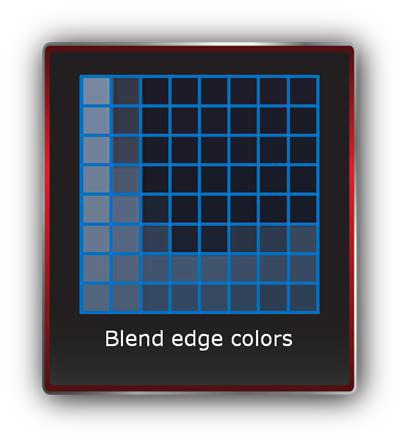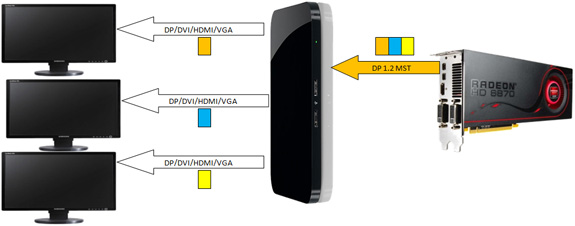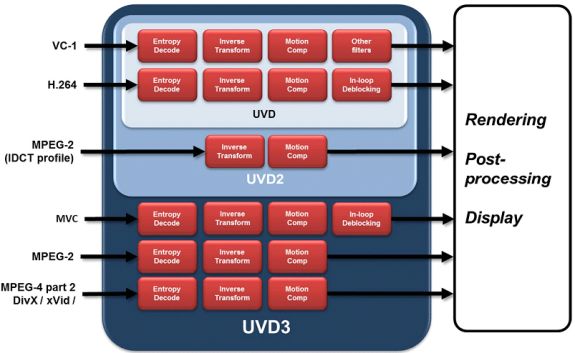AMD's Radeon HD 6970 & Radeon HD 6950: Paving The Future For AMD
by Ryan Smith on December 15, 2010 12:01 AM ESTRefresher: The 6800 Series’ New Features
Back in October AMD launched the first 6000 series cards, the Barts-based Radeon HD 6800 series. At their core they are a refreshed version of the Cypress GPU that we saw on the 5800 series, but AMD used the opportunity to make some enhancements over the standard Cypress. All of these enhancements apply throughout the 6000 series, so this includes the 6900 series. As such for those of you who didn’t pay much attention to the 6800 series, we’re going to quickly recap what’s new in order to lay the groundwork for further comparisons of the 6900 series to the 5800 series.
We’ll start with the core architecture. Compared to Cypress, Barts is nearly identical save 1 difference: the tessellator. For Barts AMD implemented what they call their 7th generation tessellator, which focused on delivering improved tessellation performance at lower tessellation factors that AMD felt were more important. Cayman takes this one step further and implements AMD’s 8th generation tessellator, which as the naming conventions implies is the 7th generation tessellator with even further enhancements (particularly those necessary for load balancing).
The second change we saw with Barts and the 6800 series was AMD’s refined texture filtering engine. AMD’s texture filtering engine from the 5800 set new standards by offering angle independent filtering, but it had an annoying quirk with highly regular/noisy textures where it didn’t do a good enough job blending together various mipmaps, resulting in visible transitions between them. For the 6800 series AMD fixed this, and it can now properly blend together noisy textures. At the same time in a controversial move AMD tweaked its default filtering optimizations for the 5800 series and entire 6000 series, leading to these cards producing imagines subtly different (and depending on who you ask, subtly worse) than they were on the 5800 series prior to the Catalyst 10.10 drivers.

| Radeon HD 5870 | Radeon HD 6870 | GeForce GTX 480 |
The third change we saw was the introduction of a new anti-aliasing mode, initially launched on the 6800 series and backported to the 5800 series shortly thereafter. Morphological Anti-Aliasing (MLAA) is a post-processing filter that works on any (and all) images, looking for high contrast edges (jaggies) and blending them to reduce the contrast. Implemented as a compute shader, it works with all games. As it’s a post-processing filter the results can vary – the filter has no knowledge of depth, polygons, or other attributes of the rendered world beyond the final image – so it’s prone to blending everything that looks like aliasing. On the plus side it’s cheap to use as it was originally designed for consoles with their limited resources, so by not consuming large amounts of memory & memory bandwidth like SSAA/MSAA it usually has a low performance hit.


Last but not least, AMD made a number of changes to their display hardware. The Universal Video Decoder (UVD) was upgraded to version 3, bringing full decode support for MPEG-2, MPEG-4 ASP, and H.264 MVC (packed frame video for 3D movies). For the 6900 series this is not of great importance as MPEG-2 and MPEG-4 ASP are low complexity codecs, but it does play an important role for AMD’s future APU products and low-end GPUs, where offloading these low complexity codecs is still going to be a big relief for the slower CPUs they’re paired with. And on that note the first public version of the DivX codec with support for UVD3 will be shipping today, letting 6800/6900 series owners finally take advantage of this functionality.
The second of the major display changes was the addition of support for the DisplayPort 1.2 standard. DP1.2 doubles DisplayPort’s bandwidth to 21.6Gbps, finally giving DisplayPort a significant bandwidth lead over dual-link DVI. With double the bandwidth it’s now possible to drive multiple monitors off of a single root DisplayPort, a technology called Multi Stream Transport (MST). AMD is heavily banking on this technology, as the additional bandwidth coupled with the fact that DisplayPort doesn’t require a clock source for each monitor/stream means AMD can drive up to 6 monitors off of a single card using only a pair of mini-DP ports. AMD is so cutting edge here that like the 6800 series the 6900 series is technically only DP1.2 ready – there won’t be any other devices available for compliance testing until 2011.

Finally, the 6800 series also introduced support for HDMI 1.4a and support for color correction in linear space. HDMI 1.4a support is fairly straightforward: the 6000 series can drive 3D televisions in either the 1080p24 or 720p60 3D modes. Meanwhile support for color correction in linear space allows AMD to offer accurate color correction for wide gamut monitors; previously there was a loss of accuracy as color correction had to be applied in the gamma color space, which is only meant for use for display purposes. This is particularly important for integrating wide gamut monitors in to traditional gamut workflows, as sRGB is misinterpreted on a wide gamut monitor without color correction.
While all of these features were introduced on the 6800 series, they’re fundamental parts of the entire 6000 series, meaning they’re part of the 6900 series too. This provides us with a baseline set of improvements over AMD’s 5800 series, on top of the additional improvements Cayman and AMD’s VLIW4 architecture brings.











168 Comments
View All Comments
Ryan Smith - Wednesday, December 15, 2010 - link
Exactly the same as on Cypress.L2: 128KB per ROP block (so 512KB)
L1: 8KB per SIMD
LDS: 32KB per SIMD
GDS: 64KB
http://images.anandtech.com/doci/4061/MidLevelView...
I don't have the register file size readily available.
DanNeely - Wednesday, December 15, 2010 - link
How likely is the decrease from 2 to 1 operations per clock likely to affect real world applications?yeraldin37 - Wednesday, December 15, 2010 - link
My current cards are running at 870Mhz(GPU) and 1100Mhz(clock), faster than stock 5870, those benchmarks for new 6970 are really disappointing, I was seriously expecting to get a single 6970 for Christmas to replace my 5850OC CF cards and make room for additional cards or even have a free pcie to plug my gtx460 for physx capability. I was going to be happy to get at least 80% of my current 5850CF setup from new 6970. what a joke! I will not make any move and wait for upcoming next generation 28nm amd GPU's. We have to be fair and mention all great efforts from AMD team to bring new technology to newest radeon cards, however not enough performance for die hard gamers. If gtx 580 were 20% cheaper I might consider to buy one, I personally never ever pay more than $400 for one(1) video card.Nfarce - Wednesday, December 15, 2010 - link
Reading Tom's Hardware they essentially slam AMD's marketing these cards as a 570-580 beater. Guru3D is also less than friendly. Interstingly, *both* sites have benches showing the 570 an d580 beating the 6950 and 6970 commandingly. What's up with that exactly?fausto412 - Wednesday, December 15, 2010 - link
it's called AMD didn't deliver on the hype...they deserve to get slammed.medi01 - Wednesday, December 15, 2010 - link
AMD delivers cards with better performance/price ratio that also consume less power. How come there is a reason to "slam", eh?zst3250 - Friday, December 31, 2010 - link
Off yourself cretin, prefearbly by getting your cranium kicked in.Mr Perfect - Thursday, December 16, 2010 - link
Wait, is Tom's reputable again? Haven't read that site since the Athlon XP was new....AnnonymousCoward - Wednesday, December 15, 2010 - link
As a 30" owner and gamer, I would never run at 2560x1600 with AA enabled if that causes <60fps. I'd disable AA. Who wouldn't value framerate over AA? So when the fps is <60, please compare cards at 2560x1600 without AA, so that I'm able to apply the results to a purchase decision.SimpJee - Wednesday, December 15, 2010 - link
Greetings, also a 30'' gamer. If you see the FPS above 30 with AA enabled, you can assume it will be (much) higher without it enabled so what's the point in actually having the author bench it without AA? Plus, anything above 30 FPS is just icing on the cake as far as I'm concerned.